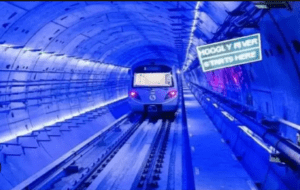India’s First Underwater Metro
Context:
The inaugural trial run of India’s maiden underwater metro took place beneath the Hooghly River in Kolkata.
Relevance:
GS-03 (Infrastructure)
India’s First Underwater Metro:
- This groundbreaking project is a crucial component of Kolkata Metro’s East-West Corridor.
- It traverses beneath the Hooghly River in the northeastern part of the city, with the tunnel situated 13 meters below the riverbed and 33 meters beneath ground level.
- The tunnel spans a total length of 520 meters and is integrated into the 4.8-kilometer underground section connecting Howrah Maidan to Esplanade.
- Upon completion, the Howrah station will become the country’s deepest metro station, reaching a depth of 33 meters below the surface.
- The underwater metro is anticipated to cover the 520-meter stretch beneath the Hooghly River in just 45 seconds.
- Emergency exits are incorporated into the tunnel design to address potential hazards like earthquakes.

Hooghly River:
- The Hooghly River, alternatively known as the Bhagirathi-Hoogly and Kati-Ganga Rivers, stands as a prominent waterway in West Bengal, stretching approximately 260 km.
- Originating in Murshidabad, it splits from the Ganges, with one branch named the Padma flowing through Bangladesh.
- The Hooghly meanders through heavily industrialized regions of West Bengal and then traverses westward and southward to meet the Bay of Bengal via a 32 km-wide estuary.
- Above Kolkata, the river is silted up, with most of its water sourced from the Farakka Feeder Canal, redirected from the Ganges by the Farakka Barrage.
- Contributing rivers such as Haldi, Ajay, Damodar, and Rupnarayan nourish its lower reaches.
- Key cities situated along its banks include Jiaganj, Azimganj, Murshidabad, and Baharampur.
- Bridges spanning the river include a cantilever bridge connecting Haora and Kolkata, as well as the Bally Bridge linking Bally and Baranagar.




